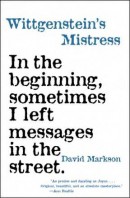 A belated post about the recent death of celebrated experimental writer David Markson. Here’s the first paragraph of the obituary written by Bruce Weber in the New York Times:
A belated post about the recent death of celebrated experimental writer David Markson. Here’s the first paragraph of the obituary written by Bruce Weber in the New York Times:
David Markson, whose wry, elliptical novels probing the scattered mind of the artist and the unruly craft of making art were frequently called postmodern and experimental and almost always surprisingly engaging and underappreciated, died Friday in his Greenwich Village apartment. He was 82.
I finally got around to reading Wittgenstein’s Mistress, about a woman who’s either insane or the last surviving person on earth—or perhaps both—a couple of years ago, and the brutal repetition of its particular experiment wore me down after a while. But I’ll certainly read more of his work.
Sarah Weinman, a fan and acquaintance of Markson, rounds up other reaction to his passing, and remembers writing about two of his early novels, more-or-less-conventional crime stories starring a detective named Harry Fannin:
Markson clearly wrote the books for money, and a way to make use of some of the genre knowledge he’d gleaned working as an editor for Dell, then one of the pulp paperback mills that couldn’t quite hold a candle to Fawcett Gold Medal’s granddaddy status. But not unlike John Banville’s pseudonymous mystery novels, the Fannin books couldn’t help but betray the rudimentary building blocks of themes and topics Markson spent his entire later career working through: baseball, bad puns, William Gaddis’ The Recognitions
, and the writer’s struggle for relevance and the artist’s relationship to creative pursuits.
Below is a clip of Markson reading from The Last Novel at the 92nd Street Y in November 2007. In his introductory remarks, he talks about his work, perhaps intentionally slipping between the singular (about that particular book) and the plural:
As a few of you know, the few of you who have read it—I see my royalty statements; the few of you—my books have no dramatic scenes, no incidents, no events, no sections that stand alone, there aren’t even any chapters. It just starts at the beginning and goes on to the end. And 98 and a half percent—that’s not really a guess, I think I counted—98 and a half percent of the book is composed of a sequence of intellectual odds and ends about writers, about painters, about composers, about performers, even sports figures. . . . There are certain themes that run through, of course, mainly about the life of the writer, the artist, and death is a major theme.

